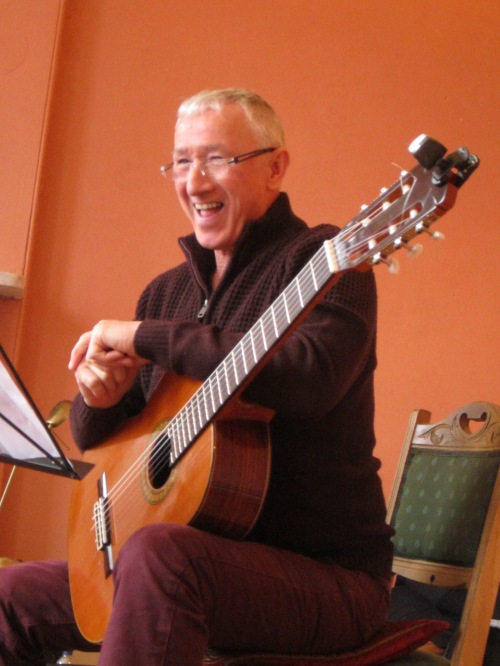Report of 25th Meeting: 10 March, 2018
Despite the bad weather, there was a decent turnout for our 25th meeting. Thanks as ever to Chris Elmes for use of his excellent venue. Much appreciated.
Bill Samson started off proceedings with a “Show and Tell’ on his newly-made cedar-topped classical guitar, after Manuel Ramirez. Bill gave a potted history of the Torres-Ramirez lineage, and put to bed the myth that it was José Ramirez who was the first to use cedar for the soundboard – the practice dates back to at least the mid 19th century.
Bill then treated us to the sounds of his new instrument, easily the best he has made so far. And it has a twin of sorts: a spruce-topped version, all other things being as equal as possible. Hopefully the spruce version will get an airing at the next meeting. Bill played a waltz by Calatayud, followed by Tárrega’s famous Lágrima – both items sounded beautiful: warm basses and singing trebles, and the guitar is only a week old! Great stuff, Bill!
Stuart McLuckie played a pavan and galliard housed in the library of Cambridge University, yet, considering its difficulty, is curiously present in a book of “Easy Pieces” from The Lute Society. There didn’t seem anything easy here, with divisions running all over the place. That said, Stuart made them look and sound fairly easy. He also got a big sound from his James Marriage lute.
Philip Lord played on a guitar from c.1830, sold by the Keith, Prowse company. I was entertained to learn that Keith is a surname…something I should have known. The guitar was given to him from his mother as a wedding present, some 50 years ago, and has lain untouched for almost as long. It’s good to see that he has finally got around to playing it! Philip has played lutes for many decades, and this is his first guitar. He is learning with a book of Carulli studies, published at the time he was given the guitar, and is therefore in good hands – Carulli wrote some delightful, and technically- and musically-satisfying studies. More next time, Philip!
A new visitor, Elspeth Mcveigh, entertained us by singing two Scottish songs: the beautiful Remember Me My Deir, and the moving Joy To The Personne. Elspeth gave a moving rendition of both songs, and were there more time available, could have sung more.
Ronnie McIntyre performed Bach’s BWV 999 on a modern classical guitar. He was clearly enjoying himself, in this well-known work.
Chris Jupp delivered his finest performance to date on a new Luke Emmet 6c. His all-Francesco programme started with a Ricercar No.4 (Ness numbering), followed by the beautiful ‘de mon triste’, and the fantasia on the same. It could be his new lute, but I’ve never heard Chris sound so good, despite running out of steam for the last four bars – no matter, it was a memorable performance. More of the same next time, Chris!
Yasuhiro Nakashima gave a good rendition of a great chaconne in C (or G for a theorbo in A) on his French theorbo. Robert de Visée’s music is never easy, and Yasuhiro did well for playing in front of an audience. There were some beautiful moments, as well as some technically challenging ones. Bravo.
Rob MacKillop surprised everyone by bringing out his new steel-strung archtop guitar. He calmed the palpitations of the confused gathering by playing and talking about the early repertoire of the instrument, and a short history of archtop guitars in general. Rob has started a website devoted to the acoustic archtop guitar, where you can read about the history of the instrument HERE, and watch a video of items from today’s performance HERE. The early repertoire (i.e. before Swing) was very often classical arrangements, and popular song arrangements. He played Schumann’s Traumerei from Arthur Black’s Modern Method for the Spanish Guitar Plectrum Style of 1933, as well as Black’s own Serenade. Rob’s guitar was made by Frans Elferink of Holland (website), one of Europe’s finest archtop luthiers. The audience enthused about the tone and resonance of this magnificent instrument, and also about the repertoire which Rob is enjoying digging up. Early Music? Certainly!









Leave a Reply